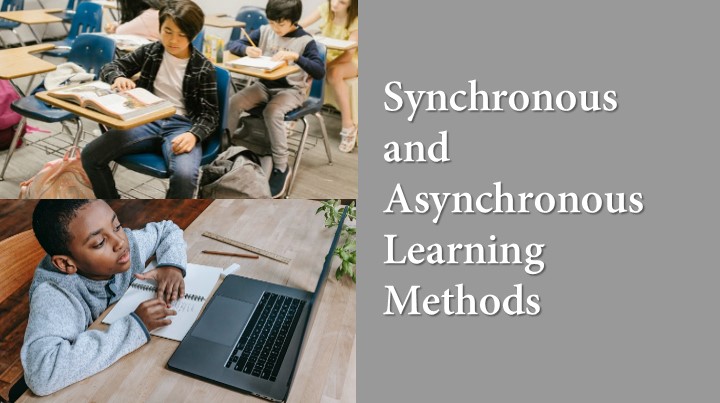Last Updated on September 28, 2024 by Uncle Pat Ugwu
As online teaching continues to grow, school owners, teachers and education stakeholders continues to discuss on the best online teaching approach to adopt. Should it be synchronous or asynchronous method of learning. What is learner’s preference when it comes to online teaching? There are different online teaching tips and tricks that should be adopted when teaching online.
In this article, I am going to discuss what synchronous and asynchronous learning is, the tools and activities of each of them and which one to use. I will also give you examples of each of them.
Now let us get started by describing each of them separately.
What is Synchronous Learning
According to Merriam-Webster Dictionary, Synchronous is when something is happening, existing, or arising at precisely the same time. Synchronous learning is a method of online teaching or distance learning where both teachers and students virtually attend a class session at the same time. This is much like the traditional on-campus classroom teaching. Teachers will have to give out offline readings and assignments to be completed after the virtual lessons.
Lecturers who are engaging this method can use a presentation software to teach while sharing his or her screen with the students. Enhancing lecture content with PowerPoint or any other presentation software will help your students to understand the content you are delivering to them.
Online synchronous learning may not all the time take the form of live video streaming kind of lecture. Sometime, it may be student lead discussions amongst themselves or together with the lecturer. A video conference call tool may be employed for this method of online teaching.
What is Asynchronous Learning
Merriam-Webster Dictionary also tells us that Asynchronous is something not simultaneous or concurrent in time. Asynchronous learning is a method of online learning that allows you to learn on your own schedule and at your own pace. Students can have access to the complete lecture materials at any time they wish to learn. Depending on how the programme is structured, there might be a time frame given to all students to complete a learning task.
One of the advantages of asynchronous online learning method is its flexibility. Learners do not have to worry on how to be online on time before the instructor. Students who want to take online studies are passionately seeking for flexibility type of learning experience. But just like on-campus studies, students taking asynchronous online learning should also try to take up lectures every other week.
Online asynchronous lessons can include short videos, reading notes, assignments and other lecture materials. It also has the capabilities to give automated and immediate feedback on their quiz and assignment, instead of waiting for lecturer to finish his grading before giving feedback.
Why Synchronous and Asynchronous
There are good reasons why both synchronous and asynchronous methods of online teaching should be adopted.
Benefits of Synchronous Learning
- Students can ask questions in real-time.
- Students feel a greater sense of community and connection to their peers when they all learn together.
- They become more engaged in their learning.
- They feel a stronger sense of collaboration.
Benefits of Asynchronous Learning
- Students can progress through the learning when they want, where they want, at the pace they want, in the order they want.
- They have more time to reflect on what they learned.
- Shy students may feel more comfortable interacting with their professor or peers when they have time to compose thought-out emails, rather than feeling pressured to speak up in a live conference.
- Students can participate in the same activities regardless of timezone.
In fact, there is much importance of technology in education.

Synchronous and Asynchronous Learning Activities and Examples
There are different learning activities and experiences in online teaching and learning. Always ask someone to proofread for you or use free grammar checker software to scrutinize your content before it goes live.
Synchronous Activities
This is mostly done with live-streaming tools or conference call apps. The host will have to provide a link or meeting ID for students to join the class. The teacher may allow a question and answer session at the end of the lecture.
Synchronous learning provides more opportunities for personalized feedback. This allows learners to make immediate adjustments to skill, knowledge and performance.
Students can engage in group activities like brainstorming since this is easily provided and facilitated synchronously.
Asynchronous Activities
Many institutions use Learning Management System (LMS) to implement this type of learning activities. LMS also has the capabilities to integrate different learning technologies, including that of live-steaming. Students will have to provide their user details to participate in the lecture.
A good activity of asynchronous learning is having a discussion board where content is presented to students on a weekly basis for questions and answers. Links to other useful information are also provided for further readings.
Other activities like chat rooms or online forums should be made available for students to hang out and interact with one another. Rules of such forum should be well spell-out to avoid privacy infringement.
Synchronous and Asynchronous Learning Tools
There are a variety of tools to support both online learning modes.
Synchronous Tools
- Live Streaming. Eg. Facebook Live, YouTube Live etc.
- Audio/Video Conferencing. Eg. Zoom, Google Meet, Microsoft Teams, Adobe Connect etc.
- Instant Chat/Messaging. Eg. WhatsApp, Telegram, WeChat etc.
- White Boarding. Eg. Google Jamboard etc.
- Application Sharing. Eg. Microsoft PowerPoint, Keynote, Active Presenter, Prezi etc.
Asynchronous Tools
- Learning Management System. Eg. Moodle, Google Classroom, WordPress, Schoology etc. We can use WordPress to build LMS for your school. Contact us.
- Web Logs or Blog. Eg. Blogger, Medium, WordPress etc.
- Email messaging. Eg. Gmail, Yahoo Mail, Mailchimp, Sender etc.
- Surveys and Polls. Google Forms, Survey Monkey, Testmoz etc.
- Website Links
You can use free graphical tools like Canva for Education to produce images for your online teaching.
Final Thoughts
Now that you have understood that there are two modes of interaction and communication in online learning or eLearning. That is synchronous and asynchronous learning. You may be wondering to know which one is better. It all depends on what works best for you and your students. The course to be delivered should also be considered, not forgetting major factors that affect education technology.
Whether you prefer synchronous or asynchronous, a combination of the two tends to yield more good results.
Please use the comment section below to ask your question or share your view. Consider joining our Facebook Group to meet with other great teachers who are interested in EdTech. Also, subscribe to this blog by email and through our YouTube and Telegram Channels to receive regular EdTech and DigiLit updates.






